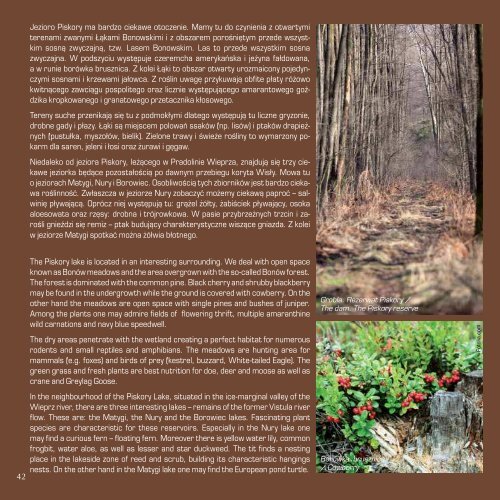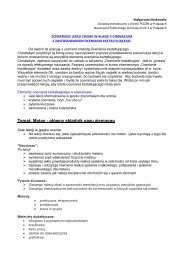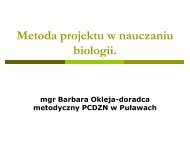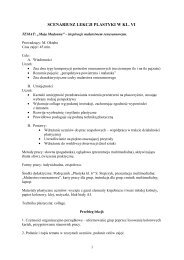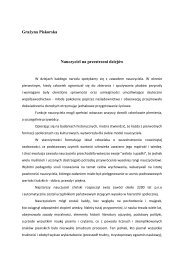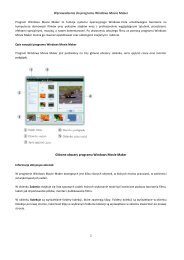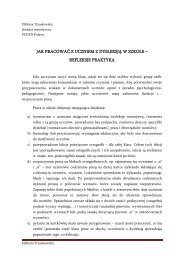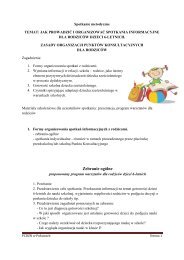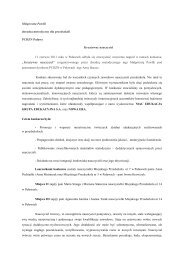Skarby przyrody Powiatu Puławskiego - Powiat Puławski
Skarby przyrody Powiatu Puławskiego - Powiat Puławski
Skarby przyrody Powiatu Puławskiego - Powiat Puławski
Create successful ePaper yourself
Turn your PDF publications into a flip-book with our unique Google optimized e-Paper software.
Jezioro Piskory ma bardzo ciekawe otoczenie. Mamy tu do czynienia z otwartymi<br />
terenami zwanymi Łąkami Bonowskimi i z obszarem porośniętym przede wszystkim<br />
sosną zwyczajną, tzw. Lasem Bonowskim. Las to przede wszystkim sosna<br />
zwyczajna. W podszyciu występuje czeremcha amerykańska i jeżyna fałdowana,<br />
a w runie borówka brusznica. Z kolei Łąki to obszar otwarty urozmaicony pojedynczymi<br />
sosnami i krzewami jałowca. Z roślin uwagę przykuwają obfite płaty różowo<br />
kwitnącego zawciągu pospolitego oraz licznie występującego amarantowego goździka<br />
kropkowanego i granatowego przetacznika kłosowego.<br />
Tereny suche przenikają się tu z podmokłymi dlatego występują tu liczne gryzonie,<br />
drobne gady i płazy. Łąki są miejscem polowań ssaków (np. lisów) i ptaków drapieżnych<br />
(pustułka, myszołów, bielik). Zielone trawy i świeże rośliny to wymarzony pokarm<br />
dla saren, jeleni i łosi oraz żurawi i gęgaw.<br />
Niedaleko od jeziora Piskory, leżącego w Pradolinie Wieprza, znajdują się trzy ciekawe<br />
jeziorka będące pozostałością po dawnym przebiegu koryta Wisły. Mowa tu<br />
o jeziorach Matygi, Nury i Borowiec. Osobliwością tych zbiorników jest bardzo ciekawa<br />
roślinność. Zwłaszcza w jeziorze Nury zobaczyć możemy ciekawą paproć – salwinię<br />
pływającą. Oprócz niej występują tu: grążel żółty, żabiściek pływający, osoka<br />
aloesowata oraz rzęsy: drobna i trójrowkowa. W pasie przybrzeżnych trzcin i zarośli<br />
gnieździ się remiz – ptak budujący charakterystyczne wiszące gniazda. Z kolei<br />
w jeziorze Matygi spotkać można żółwia błotnego.<br />
The Piskory lake is located in an interesting surrounding. We deal with open space<br />
known as Bonów meadows and the area overgrown with the so-called Bonów forest.<br />
The forest is dominated with the common pine. Black cherry and shrubby blackberry<br />
may be found in the undergrowth while the ground is covered with cowberry. On the<br />
other hand the meadows are open space with single pines and bushes of juniper.<br />
Among the plants one may admire fields of flowering thrift, multiple amaranthine<br />
wild carnations and navy blue speedwell.<br />
The dry areas penetrate with the wetland creating a perfect habitat for numerous<br />
rodents and small reptiles and amphibians. The meadows are hunting area for<br />
mammals (e.g. foxes) and birds of prey (kestrel, buzzard, White-tailed Eagle). The<br />
green grass and fresh plants are best nutrition for doe, deer and moose as well as<br />
crane and Greylag Goose.<br />
Grobla. Rezerwat Piskory /<br />
The dam. The Piskory reserve<br />
Fotolia.com<br />
In the neighbourhood of the Piskory Lake, situated in the ice-marginal valley of the<br />
Wieprz river, there are three interesting lakes – remains of the former Vistula river<br />
flow. These are: the Matygi, the Nury and the Borowiec lakes. Fascinating plant<br />
species are characteristic for these reservoirs. Especially in the Nury lake one<br />
may find a curious fern – floating fern. Moreover there is yellow water lily, common<br />
frogbit, water aloe, as well as lesser and star duckweed. The tit finds a nesting<br />
place in the lakeside zone of reed and scrub, building its characteristic hangings Borówka brusznica<br />
nests. On the other hand in the Matygi lake one may find the European pond turtle. / Cowberry<br />
42 Sarna / Doe 43


